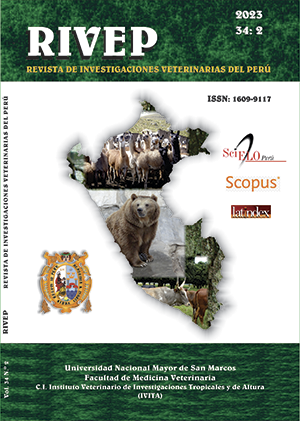Factors associated with injuries caused in dog bite accidents
DOI:
https://doi.org/10.15381/rivep.v34i2.19593Keywords:
bites, dogs, accidental injuries, risk factorsAbstract
The aim of this study was to determine the frequency of dog bite accidents in the city of Abancay, Peru, during the years 2008-2012 and to determine factors associated with the injuries caused. The study population corresponded to all the people treated for dog bites in health centres and in the Guillermo Díaz de la Vega Hospital. Odds ratio tests, confidence intervals, Pearson's Chi square, and multivariate logistic regression were performed. In total, 1151 dog bite accidents were recorded, mostly in summer (p<0.05), in males (53.9%), 0-11 years of age (34.5%), residing in an urban area (83.1%) and occurring in public roads (60.5%) (p<0.01). In addition, the highest proportion of injuries occurred in the lower limbs (61.3%), with a single (64.1%) and superficial (64.8%) lesion (p<0.01). Most of the biting dogs were known by the offended (68.1%), they were medium sized (46.2%), females (66.5%) and "creole" type (87.4%) (p<0.01). People bitten in the peri-urban area and who acquired multiple lesions were 1.5 times more likely to present deep lesions (OR=1.5; p<0.05). In conclusion, dog bite accidents have increased over time and the peri-urban area in which the accident occurred, and the multiple injury caused by the bite were associated with deep injuries.
Downloads
Downloads
Published
Issue
Section
License
Copyright (c) 2023 Eugenia Obispo Boza, Aldo Alim Valderrama Pomé

This work is licensed under a Creative Commons Attribution 4.0 International License.
AUTHORS RETAIN THEIR RIGHTS:
a. Authors retain their trade mark rights and patent, and also on any process or procedure described in the article.
b. Authors retain their right to share, copy, distribute, perform and publicly communicate their article (eg, to place their article in an institutional repository or publish it in a book), with an acknowledgment of its initial publication in the Revista de Investigaciones Veterinarias del Perú (RIVEP).
c. Authors retain theirs right to make a subsequent publication of their work, to use the article or any part thereof (eg a compilation of his papers, lecture notes, thesis, or a book), always indicating the source of publication (the originator of the work, journal, volume, number and date).










